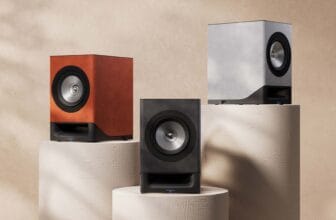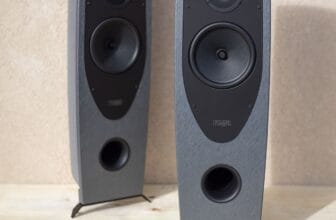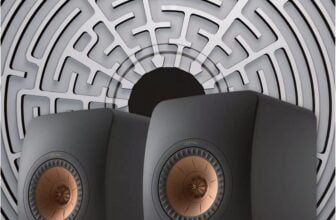Bowers & Wilkins 801 D4 Review
WHEN THE BOWERS & WILKINS 801 LOUDSPEAKER FIRST SAW the light of day in 1979, it was immediately received with enthusiasm by discerning audio hobbyists and recording professionals alike. Famously, EMI’s Abbey Road facility adopted the speaker as its reference monitor, and other studios followed suit. The original was a bit clunky-looking: a dimple of a tweeter perched atop a breadbox-sized midrange module that sat on a much larger, squarish bass enclosure. The visual effect, to me at least, was that of a wedding cake gone wrong. The latest iteration of the 801, the D4, is now available and, while the appearance is far more elegant than its earliest progenitor, an observer transported from 1979 to the present would have no difficulty identifying the 801 D4 as a direct descendant. The 801’s most basic design principles have been preserved, but also advanced and refined over four decades of continuous consideration by the engineers at B&W That, by the way, was the last time I’ll be using “B&W” in this review. When I used it, repeatedly, in an email posing questions to the manufacturer, I got back the kind of firm but polite rebuke that only the Brits can muster. “Please note the name of our brand is Bowers & Wilkins, not ‘B&W,’” wrote Andy Kerr, the company’s Director of Product Marketing and Communications. “We moved away from using ‘B&W’ over a decade ago.” I felt like I was around twelve and a parent/teacher conference was in my immediate future. I promise the term will never pass my lips again.
BY ANDREW QUINT
PHOTOS BY MATT WRIGHT-STEEL
In a real sense, it was the original 801 that was the “revolutionary” product in this loudspeaker’s extraordinary run of 43 years (thus far). The use of computer modeling and what the company called “numerical optimization” to develop the crossover network were largely unheard of at the time, and the use of separate enclosures for the treble, midrange, and bass transducers, appearance be damned, was novel as well. The three subsequent generations of 800 Series loudspeakers that followed had a sonic heritage to build upon, a design and manufacturing tradition that would readily accommodate—embrace, really—new developments in measurements, materials, and production methodologies. Pretty much everything inside and outside the flagship 801 D4 is different from the original loudspeaker of 1979, but the basic engineering concepts and sonic character are not. Note the reference to the 801 as Bowers & Wilkins’ “flagship” product. What about the sculptural Nautilus, still very much in production and costing $ more than the $-per- pair 801 D4s? Andy Kerr left no doubt as to the company’s view of the hierarchy. “Regarding Nautilus: It’s a beautiful, great-sounding, and iconic loudspeaker, for sure, but it’s not the best we make. It’s been surpassed in a few key areas by newer generations of loudspeaker technology. The 801 D4 is, without question, our flagship model.”
The “D” in the model number refers to the diamond material used to form the 1″ dome tweeter’s diaphragm in all the 800 Series speakers, a technology introduced in 2005 that results in an extraordinarily high first-breakup frequency of over 70kHz. The housing for the free-mounted tweeter is still milled from a solid block of aluminum but its shape is now different, and there’s a longer tube-loading apparatus, nearly twelve inches in length, that the manufacturer feels is responsible for a more open top end.
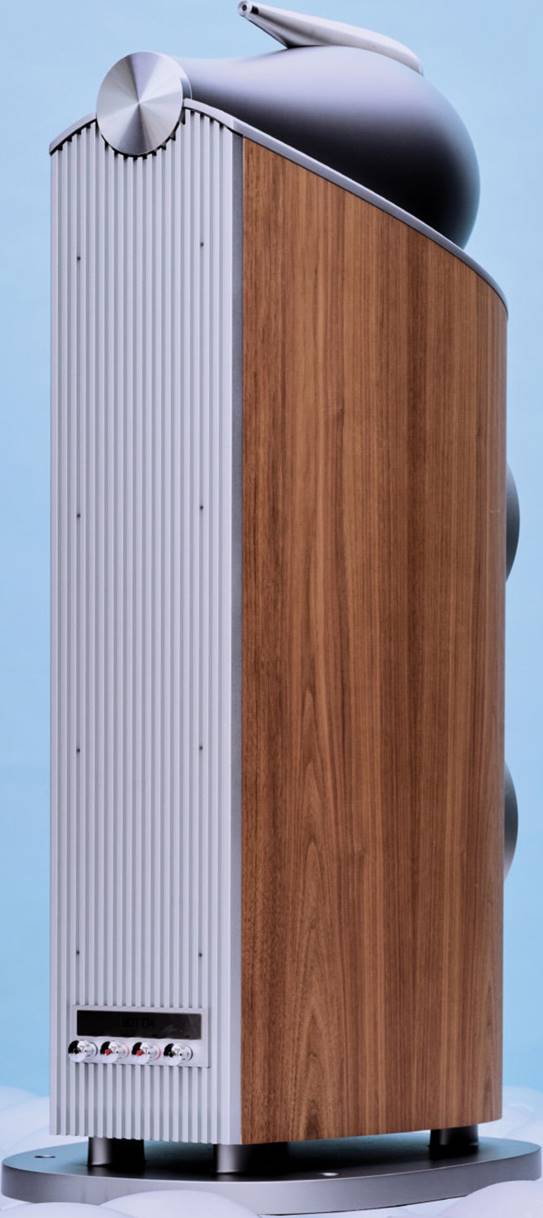
Bowers & Wilkins goes to quite extraordinary lengths to mechanically isolate the proprietary Continuum FST cone that’s responsible for midrange reproduction from the rest of the speaker. The all-aluminum housing for the 6″ midrange transducer, referred to as the Turbine Head, is exceptionally rigid and internally damped; the driver assembly itself “floats” at the end of a spring mounting rod, secured in front by six silicone decoupling points. For the D4 iteration, Bowers & Wilkins has introduced what it calls the Biomimetic Suspension system to improve the mechanical behavior of the driver’s fabric spider, a critical component of dynamic transducers that connects voice coil to basket. The new technology is meant to prevent the spider from generating air movements independent of those the Continuum cone is supposed to be producing, and thus to eliminate a source of potential distortion.
A pair of 10″ Aerofoil woofers, vented towards the floor via the company’s Flowport, completes the 801 D4’s driver complement. They feature a new anti-resonance plug in the voice coil, designed to reinforce the voice coil and prevent it from flexing.
The 801’s enclosure has come a long way in performance and appearance since the utilitarian boxiness of the first edition. A gentle roundness dominates the visual presentation. The front and sides of the speaker are fabricated as a single, continuous curve—a “reverse wrap”—that attaches to a solid aluminum spine behind. Having a curved front means there is less baffle around the woofers, resulting in improved dispersion and reduced reflections. Bowers
I WAS IMPRESSED RIGHT OUT OF THE GATE
& Wilkins has long employed an internal Matrix construction, a system of interlocking plywood panels configured with foam-filled cells in two perpendicular planes that help assure a resonance-free cabinet. The D4 iteration of the 801 has fewer of the panels, but adds strategically placed aluminum braces glued and bolted into position. New for the 801 D4 is an aluminum plate around the downward-facing Flowport. An aluminum top plate, also new, further increases the stiffness of the speaker’s cabinet and helps with decoupling the midrange and tweeter elements from the large compartment below
The crossover can be considered “external,” as it’s attached to the inner surface of the aluminum spine at the rear of the speaker. The crossover frequencies, Kerr informed me, were “roughly” 350Hz and 4kHz. Premium electronic components from Mundorf, Powertron, and Angelique are used for the network. At the rear of the 801 D4s are 5-way binding posts—two sets, to allow bi-wiring or bi-amping.
The loudspeakers come with very substantial grilles for the midrange and the two bass drivers, cloth-covered metal-mesh structures that attach magnetically. They are surprisingly transparent. Placing my ear near the Turbine Head and moving the grille for the midrange cone in and out of position didn’t change the character of the soft hiss emanating from the driver. Leaving the grilles in place could make a big esthetic difference to the non-audiophile in your life, and one shouldn’t fear that there’s any serious sonic compromise to doing so. The 801 D4s are available in four standard finishes—gloss black, white, satin rosenut, and satin walnut. In another move to up the luxury quotient of the 801 D4s, the surface beneath the Turbine Head now has a soft leather covering, sourced from a British firm (Leather by Connolly) that supplies this material to automotive manufacturers.
The 801 D4 has an integral all-aluminum plinth; the previous generation used a zinc-alu- minum alloy. Bolted to the undersurface of the plinth are four wheels that allow the owner to move the speakers, once unpacked, into their approximate room position for fine-tuning their setup. Once that’s been accomplished, built-in spikes—considerably more robust than the D3’s—are lowered using a supplied tool. In the process, the wheels are lifted off the floor. (If desired, one can remove the wheels with an Allen wrench—definitely a two-person operation.

A conventional spider (right) and Bowers & Wilkins’ new Biomimetic Suspension (left).
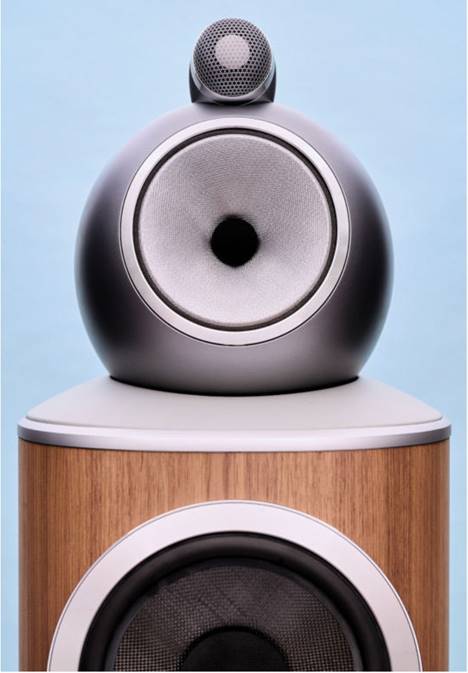
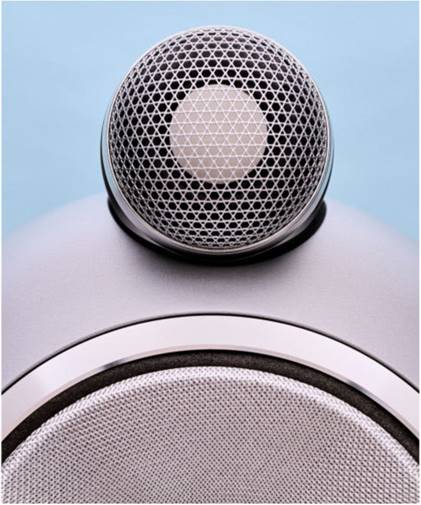
This may be mandatory if the 801s are sitting on an especially thick carpet.) The spikes have metal cups attached, but they are readily removed if the speaker is sitting on a carpet.
The 801 D4s are heavy, bulky loudspeakers. Like many other large speakers, they are thoughtfully packed, both to protect the product from the rigors of shipping and—theoretically—allow an end-user to unpack the 801s himself by following the instructions printed on the outside of the cardboard boxes. Don’t do it. Like many things in life, from replacing the turn-signal bulb in a German car to intimate relations, it’s accomplished much more effectively after you’ve done it a few times, and, of course, you’re probably not going to be undertaking this procedure terribly often. Let the dealer unpack them and get them near to their final destination, even if there’s a charge involved. It’ll be better for all the fingers, backs, and parquet floors involved.
The Bowers & Wilkins 801 D4s ended up located where most large dynamic loudspeakers do in my 15′ by 15′ room, especially when there’s no rear-firing port. They were positioned about two feet from the CD- lined wall behind them, approximately eight feet apart and eight or nine feet from the listening position. The associated equipment utilized for this review is listed in the sidebar.
The first music I listened to through the 801s, even before final positioning and spiking, was my go-to reference symphonic selection for equipment assessment, a 2010 RCO Live recording with the late Bernard Haitink conducting the Concertgebouw Orchestra in Dmitri Shostakovich’s Symphony No. 15, specifically the opening movement. I was impressed right out of the gate. Many instruments get a turn in the spotlight as soloists—violin, string bass, piccolo, bassoon, trumpet, xylophone, etc.—and all were properly scaled and tonally believable. These large and imposing loudspeakers were light on their feet, uncovering the full range of detail and dynamic nuance that characterizes this recording. As I moved on to other music, the 801s continued to delight with their revelatory coherency. Not a clinical or sterile sort of clarity, mind you, but one that served musical meaning.

The original 801, circa 1979.
As a dyed-in-the-wool Steely Dan fan, I’m a little embarrassed to admit to miss ing, until quite recently, a two-CD set released in 2006 titled Maestros of Cool.. It’s what you’d call a “tribute album,” with covers of 20 SD songs by a variety of artists with musical styles ranging from indie pop to jazz to hip-hop There are also several original songs intended to channel the essence of Becker and Fagen’s creations, the best of which is “Remember” from a
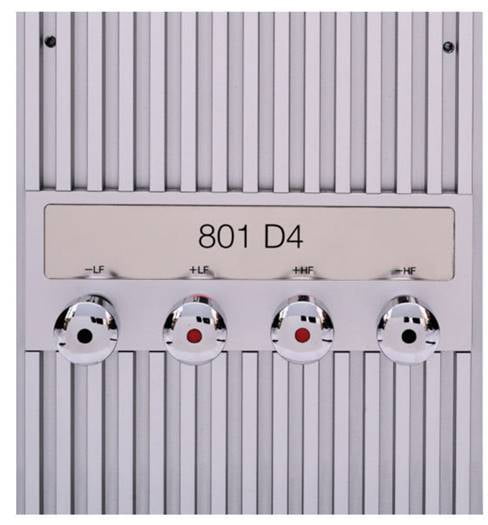
band called SteReO. All the tropes are there—the unpredictable jazz-flavored chord progressions, elliptical lyrics, the rhythmic hitches and pauses that set up memorable hooks and refrains. But what makes the song truly an homage are the arrangement and production—the loping bass, the keyboard and guitar filigree, the commentary by unison trumpet and sax, the way the backup singers support the lead vocal as economically as possible, the wheezy organ that wanders through the mix. All these details that matter so much to the musical success of the song are laid out in sharp relief. This is due, of course, to the meticulous engineering and mixing of the recording—but also to the transparency and coherency of the 801’s presentation.
The Bowers & Wilkins product is also revealing in a nerdy audio sense. They will tell you what you need to know, like it or not, about the rest of your stereo system. Cables, for instance. Establishing which wires work best with an unfamiliar loudspeaker can be a tedious undertaking that leaves one doubting his judgment after an hour or two. It didn’t seem that way with the 801 D4s. I tried my usual Transparent Ultra speaker cables, which bested a single pair of T+A Speaker Hex cables. However, bi-wiring with two sets of the T+As was best of all and, for once, there wasn’t a great deal of agonizing involved in the assessment.
This very positive appraisal duly registered, it’s time to address a potentially consequential issue, namely the demands the Bowers & Wilkins 801 D4 makes on the amplification preceding it in the audio chain. During my first weeks with the 801s, I remained enthralled by the way they uncovered the basic nature of all stripes of music they encountered—but also began to sense a lack of control and “grip” with dynamic source material. I’m not just talking about grand opera and headbanger met-
THE BOWERS & WILKINS PRODUCT IS ALSO REVEALING IN A NERDY AUDIO SENSE
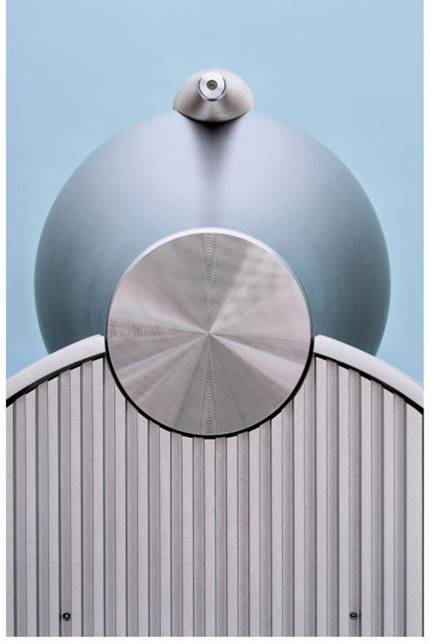
al; a well-made solo piano recording could also alert me to the issue. My 60W Pass XA 60.8 monoblocks were clearly falling short; substituting the 200Wpc David Berning Quadrature Zs got better results, but I was still “leaning in” to fully engage with the music.
This isn’t a new observation, by any means. The 801s have long had a significant impedance drop from the upper bass to the middle midrange. Although Andy Kerr explained that the D4 version of the speaker was “somewhat kinder than the D3” in this regard, it still requires a lot of power, and the right kind of power, to perform at its best. I’m certainly not a measurement kind of audiophile—my skills are rudimentary, and my engineering background is nil—but I do have a Dayton Audio OmniMic V2 system that I use for taking measurements from the listening position to optimize subwoofer integration and to at least take a look at the in-room frequency response of the loudspeakers here for

review. I connected it up, played sine wave sweeps and, with the Berning amplifiers, saw an 8-to-10dB depression between 200 and 1000Hz. The lower bass was messy, as well. Clearly, I needed to hear the 801s with more robust amplification. The nearby dealer Doug White (The Voice That Is) loaned me the new Tidal Intra stereo amp that delivers 330Wpc into an eight-ohm load and 670 watts into four. The substitution of the Intra for the Quadrature Zs was transformative. The measured dip decreased to just 2-to-3dB and, subjectively, there was an obvious improvement in immediacy and control.
Employing the sort of generalizations that we audiophiles tend to make, it would be easy enough to declare that the new 801s have “good bass,” and move on to the next sonic parameter. But what does that mean? “Bass” isn’t a monolithic aspect of either music or sound reproduction, defined simply by a frequency value. There’s the bass foundation that gives “weight” to an orchestral recording, the “fat” bass on vintage Motown tracks, or the highly dimensional bass that emanates from a stand-up acoustic instrument in a jazz trio.
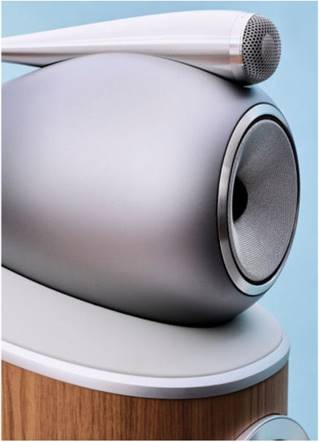
There’s the subterranean bass generated by a synthesizer, and the full, resonant underpinning a cello provides to a string quartet. There’s tuba bass, contrabassoon bass, and even harp bass. (Andreas Vollenweider, anyone?) Of course, there’s organ bass, those 16- and 32-foot stops made of wood or metal. There are several percussive styles of playing electric bass, the stomach-churning bass heard with some hip-hop, or the sound of those extra nine bass notes on an Imperial Bosendorfer. The 801s do all these species of bass convincingly.
Perhaps counterintuitively, it’s the full-range speakers with the best LF performance that are most successfully integrated with a subwoofer to provide those last few hertz of bottom-end extension and define the volume of a large concert hall or cathedral. As noted above, the in-room frequency response of the 801’s bottom octave, with the Berning amps providing power, was wildly uneven; adding a subwoofer would have been pointless. With the Tidal Intra driving the speakers, there was a very smooth roll-off beginning at about 38Hz in my room, and it was not difficult to dial in my Magico S-Sub. (The 801 D4’s published -3dB LF specification is 15Hz, which is surely “optimistic” in most real-world listening environments.) On the (in)famous Jean Guillou recordings of Cesar Franck’s organ music on the Dorian label, with sub activated, the music accrued more authority—a majesty that went beyond just rattling the vases in the china cabinet.
What other aspects of sound reproduction do the new Bowers & Wilkins bring off with aplomb? There’s the delineation of instrumental color—it was as easy as it’ll ever be for me to distinguish a Guarneri violin from a Stradivarius. How about dynamic shading and gradation? Listen to the “Abime des oiseaux” movement of Messiaen’s Quartet for the End of Time, which has the clarinetist, unaccompanied, slowly growing the volume and intensity of THERE WAS AN OBVIOUS several very long tones. Atmosphere? IMPROVEMENT IN Check out the off-stage post-horn solo
IMMEDIACY AND CONTROL over muted strings in movement three of Mahler’s Symphony No. 3. The 801s are fast—they’ll keep up with the virtuosity of a Bela Fleck or Marc-Andre Hamelin— and they’ll render the most characteristic symphonic textures idiomatically.
The comprehensiveness of the 801 D4’s sonic strengths is apparent, I should say, even with amplifiers that don’t entirely conquer the impedance drop described above. One certainly should not conclude that there are only a few amps out there that will do the job. Just a few days after I parted ways with the review pair, for example, I heard the new 801s at Capital Audio Fest played with a pair of McIntosh MC901s, the solid-state section driving the woofers and the tube section handling the upper drivers. The results were stunning.
Unless you view the fact that the Bowers & Wilkins 801 D4s demand stout and sturdy amplification to sound their best as a demerit, they are a loudspeaker without any musically consequential deficiencies. If you listen to nothing but Renaissance recorder music, these speakers will give you a sound that’s airy, dimensional, and tonally correct. If it’s Death Metal that floats your boat, you won’t be disappointed, either—they’ll render all the slashing, bashing, and growling with as much attitude as you could hope for. Best of all, if you indulge in the Baltimore Consort in the afternoon and Cannibal Corpse after dark, the 801s won’t bat an eye.
There’s a final point that should be made. For most people, $ is a lot of money for an audio expenditure. In the world of elite loudspeakers, however, that kind of outlay doesn’t get you to the middle of many manufacturers’ product ranges. The Bowers & Wilkins 801 D4s actually represents a terrific value. For your investment, you’re getting a flagship transducer with a legacy of steady, incremental improvement over time, a speaker that’s been 40-plus years in the making. Surely a classic.
SPECS & PRICING
Type: Three-way dynamic loudspeaker system with a top-mounted tweeter, Turbine Head midrange enclosure, and downward ported bass enclosure. Driver complement: 1″ diamond dome tweeter, 6″ Continuum cone FST midrange, two 10″ Aerofoil cone woofers Frequency response: 15Hz-28kHz (±3dB)
Nominal impedance: 8 ohms Sensitivity: 90dB Dimensions: 17.8″ x 48.1″ x 23.6″ Weight: 222 lbs.
BOWERS & WILKINS 5541 Fermi Ct.
Carlsbad CA 92008 bowerswilkins.com
ASSOCIATED EQUIPMENT
Analog: Vertere MG-1 turntable with SG-1 tonearm, Acoustical Systems Archon cartridge
Digital: Baetis Reference 3 music computer, Ideon Absolute DAC, Sony UBP-X1100ES (used as transport) Network: Synology DS1813+, DX513, and DS1815+, NAS Fidelizer Etherstream switch, Supra Ethernet cables Preamplifier: Pass Labs XP-22 Phonostage: Pass Labs XP-27 Amplifiers: Pass Labs XA 60.8 monoblocks, David Berning Quadrature Z monoblocks, TIDAL Audio Intra Subwoofer: Magico S-Sub Cables: Analog: Transparent Gen 5 Ultra balanced interconnects and speaker cables; Transparent Super single-ended interconnects (subwoofer), T+A bi-wire speaker cables;
Digital: Shunyata Anaconda AES/EBU, Apogee Wyde Eye SPDIF Miscellaneous: Aramateria feet; Transparent Audio powerline conditioner; HD- Plex linear power supply; GIK Acoustics N23 5″ Skyline diffusers



